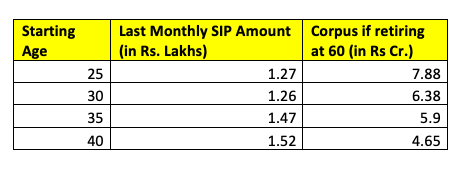Most of us can relate with this – We make plans, but life and chance come in the way. When it comes to investing, considering that it doesn’t show any immediate benefits, it is one of those decisions many of us tend to put off for later.
From low earnings in the initial phase of our careers to higher expenses post marriage, the reasons are many that we fall back on. What little we save often ends up either in just the savings account or at best an FD even for years together.
We do end up getting our collective acts together later on when concerns for our child’s future or a drying up job market force us to think seriously about investing. But is there a cost to investing later on in life, rather than earlier?
Let’s let the numbers do the talking:

The above table considers investments in a portfolio of equity mutual funds delivering 12% annualised. The SIP is bumped up by 10% each year in all cases.
Someone starting in their 40s with a SIP 5x greater than the 25-year-old and retiring at the same time will have a corpus of Rs 4.65 Cr. That’s about Rs 3.23 Cr less.

Let’s list down what it tells us.
#1. Starting at 25, someone starting investing with just a Rs 5,000 SIP should accumulate a neat Rs 7.9 Cr.
#2. Someone starting in their 40s with a SIP 5x greater than the 25-year-old and retiring at the same time will have a corpus of Rs 4.65 Cr. That’s about Rs 3.23 Cr less.
#3. Delaying investing by 5 years in the case of the 30-year-old has meant a corpus 1.5 Cr smaller.
#4. In the case of an early retirement, only the 25 and 30-year-old investors will have a significant enough portfolio. The 40-year-old despite investing a lot more as a starting SIP will have a corpus that is less than half of the 25-year-old who started the earliest.
Now those inclined towards numbers might argue that considering the 10% bump up in SIPs the 25-year-old would be paying a huge SIP amount. That’s sort of correct but look at the numbers for all the four cases:
The early starters (interestingly the 25 and 30-year-old will pay the same last SIP amount), pay almost Rs 20,000 less than the late starters.
There’s a late fine
The numbers tell us that there are very real consequences to delaying investing. If you have just 10 years less to save for retirement, you’d have to start with at least a Rs 20,000 SIP to match the corpus of someone starting at 25 with Rs 5,000 each month. That’s a 4x bigger SIP amount for almost the same corpus.
The more you delay, the less time you have to compound your investments. Reaching an inflation adjusted corpus that is cost efficient in terms of the actual investment from your side depends a lot on the time you give your investments.
The inference is clear. Delaying investing for long term goals costs real money that can’t simply be made up by investing marginally more. You’d have to invest a lot more to match someone who started early. This means greater pressure on your savings to meet the same financial goals.
So the next time, you consider delaying your investment decision, ask yourself – “Can I afford paying a late fine?”


















































































































Show comments